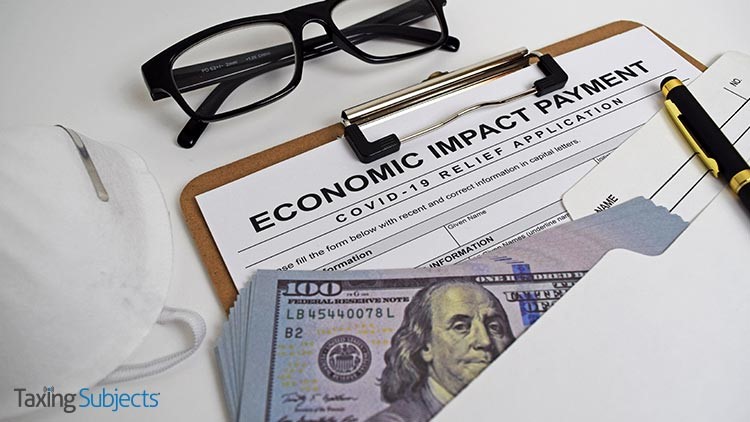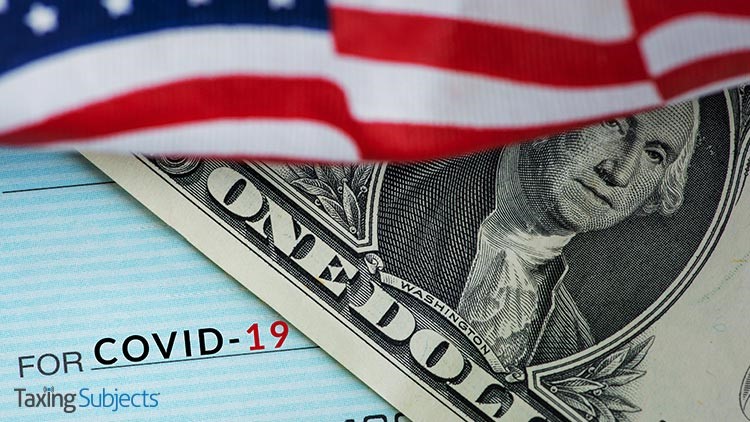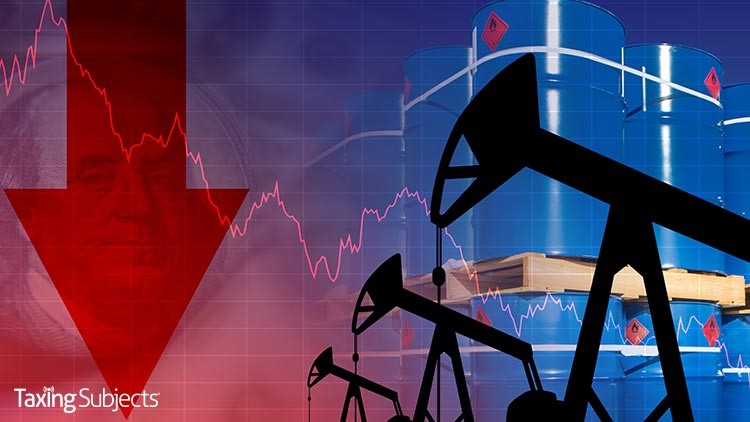by Socheata Ten EA, LLC | May 14, 2020 | Tax Tips and News
How many Economic Impact Payments have been issued?
Many Economic Impact Payment reporting deadlines are now fixed in the country’s rear-view mirror, and millions of Americans have started receiving payments from the US Treasury Department. That begs the question: Just how many people have received a CARES Act-authorized payment? The answer is found in a recent Internal Revenue Service press release that breaks down the figures by state.
The IRS announced that close to 130 million taxpayers have now received an Economic Impact Payment—up from the 88 million toward the end of April—bringing the total amount of money issued to more than $200 billion.
The five states that have received the most money in payments are California ($22 billion), Texas ($18 billion), Florida ($15 billion), New York ($12 billion), and Pennsylvania ($8 billion). South Dakota, North Dakota, Arkansas, Vermont, and Wyoming round out the bottom of the list, collectively receiving $2.5 billion dollars.
It’s worth noting that the IRS included taxpayers from the District of Columbia and those with foreign addresses in the final count. As of May 8, the agency said that 252,095 DC residents and 595,548 foreign address holding filers have received an EIP.
Will the Treasury issue more Economic Impact Payments?
While the IRS reminded Americans that those who recently filed a tax return and certain recipients of government benefits will have their EIP issued automatically, some non-filers may still need to provide the IRS with qualifying information to receive a payment.
“For those who don’t receive federal benefits and didn’t have a filing obligation in 2018 or 2019, the IRS continues to encourage them to visit the Non-Filer tool at IRS.gov so they can quickly register for Economic Impact Payments,” the IRS urged. “People can continue to receive their payment throughout the year.”
The IRS closed the release with a link to the Economic Impact Payments FAQ page, which answers common questions like the following:
- “Who is eligible?”
- “Who is not eligible?”
- “How much is it worth?”
- “Do I need to take action?”
To view current EIP statistics for all 50 states, visit IRS.gov.
Source: IR-2020-91
– Story provided by TaxingSubjects.com
by Socheata Ten EA, LLC | May 12, 2020 | Tax Tips and News
The US Treasury Department has found a loophole in the stimulus payments sent out to individuals. Some of the recipients were actually deceased—and Treasury wants that money back.
Accounting Today magazine reports the government became aware in April when some people noticed that family members who had recently died still got the $1,200 Economic Impact Payments.
The federal government updates taxpayer rolls regularly, incorporating new data with death certificate information, but the magazine said the IRS was relying on data to process the payments that had been gathered as long ago as 2018.
The stimulus payments—$1,200 for each adult earning up to $75,000 and an additional $500 for each child under age 17—began showing up in bank accounts in April. Tens of millions of checks remain to be distributed.
When the program was announced, the IRS said those who received more money than they were due because of changes in income would not have to return the difference. It’s not known if those who fail to return dead relatives’ payments to the government would face legal action.
Accounting Today says the IRS and Treasury are planning to issue their guidance on the mistaken payments in a few days.
– Story provided by TaxingSubjects.com
by Socheata Ten EA, LLC | May 9, 2020 | Tax Tips and News
The Internal Revenue Service is reminding employers who have been impacted by the Coronavirus pandemic that three new credits are available for them.
The first of these, the Employee Retention Credit, is intended to encourage businesses to keep employees on the payroll. The ERC is a refundable tax credit of 50% up to $10,000 in wages paid by an eligible employer whose business has been financially affected by COVID-19.
The credits available to all employers, regardless of size, and includes tax-exempt organizations. The IRS says there are only two exceptions to this credit: State and local governments and their instrumentalities, and small businesses who take small-business loans.
What are the qualifications for employers?
There are only two qualifications and employers have to meet one or the other:
- The employer’s business is fully or partially suspended by government order due to COVID-19 during the calendar quarter.
- The employer’s gross receipts are below 50% of the comparable quarter in 2019. Once the employer’s gross receipts go above 80% of a comparable quarter in 2019, they no longer qualify after the end of that quarter.
Employers will calculate these measures each calendar quarter.
What are the paid sick leave and family leave credits?
The paid sick leave credit is aimed at giving businesses a tax credit for an employee who is unable to work (including working from home) because of Coronavirus quarantine or self-quarantine. It also applies if the employee has Coronavirus symptoms and is seeking a medical diagnosis.
Those employees are entitled to paid sick leave for up to 10 days (up to 80 hours) at the employee’s regular rate of pay up to $511 per day and $5,110 in total.
Employees are also entitled to paid family and medical leave amounting to two-thirds of the employee’s regular pay, up to $200 per day and $10,000 in total. Up to 10 weeks of qualifying leave can be counted toward the family leave credit.
Businesses can be reimbursed immediately for the credit by reducing their required deposits of payroll taxes that have been withheld by the amount of the credit.
Eligible employers can immediately get a credit in the full amount of the required sick leave and family leave—plus related health plan expenses and the employer’s share of Medicare tax on the leave—for the period of April 1, 2020, through Dec. 31, 2020. The refundable credit is is applied against employment taxes on wages paid to all employees.
How do businesses get the Employee Retention Credit?
The IRS says getting the credit is as simple as reducing the required deposits of payroll taxes that have been withheld from workers’ wages. The reduction is made by the amount of the credit.
An IRS release has further details: “Eligible employers will report their total qualified wages and the related health insurance costs for each quarter on their quarterly employment tax returns or Form 941 beginning with the second quarter. If the employer’s employment tax deposits are not sufficient to cover the credit, the employer may receive an advance payment from the IRS by filing Form 7200, Advance Payment of Employer Credits Due to COVID-19.”
For more information about these credits, check out Employee Retention Credit FAQs and Paid Family Leave and Sick Leave FAQs, or the IRS fact sheet on the Employee Retention Credit.
– Story provided by TaxingSubjects.com
by Socheata Ten EA, LLC | May 8, 2020 | Tax Tips and News
From mid- to late-March, the Tax Court cancelled a number of pending cases amid safety concerns stemming from the growing threat of the COVID-19 epidemic. Despite defendants no longer having their expected day in court, the orders suggested that all involved parties try to resolve those cases. This week, the Internal Revenue Service announced a remote solution for taxpayers without legal representation: “Virtual Settlement Days.”
Previously, Settlement Days have been in-person, volunteer-hosted events that provide unrepresented taxpayers access to resources like free tax advice, legal representation, and settlement opportunities—usually resulting in a settlement. “Those who ended up with a liability have been able to enter into an installment payment arrangement,” the IRS explained, highlighting how these events have helped taxpayers address their tax bill.
What are Virtual Settlement Days?
Virtual Settlement Days are remote tax clinics hosted by volunteer tax advisors and IRS staff that provide unrepresented taxpayers access to free tax advice and resolution services via a teleconferencing application. By meeting over the Internet, taxpayers can continue to observe stay-at-home orders while dealing with their Tax Court case.
How will unrepresented taxpayers attend Virtual Settlement Days?
Virtual Settlement Days will use Cisco’s WebEx teleconferencing application to remotely connect taxpayers with volunteer tax advisors. WebEx, like other remote meeting platforms, requires that users create an account and learn how to join meetings. To help address the potential learning curve, Cisco has a series of written and video guides on its Help Center page.
When will the Virtual Settlement Days events begin?
While this program could expand access to Low Income Taxpayer Clinics, the rollout is limited to a select number of taxpayers whose cases were cancelled in Detroit, MI, and Atlanta, GA. Initially planned as one-day events—May 9 in Detroit and May 21 in Atlanta—the IRS noted that these first Virtual Settlement Days “may be extended, if needed, to meet taxpayers’ needs.”
How will taxpayers know if their case has been selected for a Virtual Settlement Days?
According to the press release, the IRS is sending invitations to eligible taxpayers. The agency will give preference to unrepresented taxpayers whose cases were recently cancelled by the Tax Court, but they said they will also invite those who do not yet have a trial scheduled.
How long will the IRS support the Virtual Settlement Days program?
Interestingly, the IRS had been considering the addition of teleconferencing to Settlement Days before social distancing policies were widely implemented in the US. The agency noted that Chief Counsel had included remote-meeting recommendations in the January 2020 Settlement Days Best Practices; the coronavirus simply underscored the immediate need. As such, “Chief Counsel anticipates that Virtual Settlement Days will be a mainstay of its Settlement Day efforts even after the crisis is over.”
Source: IR-2020-87
– Story provided by TaxingSubjects.com
by Socheata Ten EA, LLC | May 7, 2020 | Tax Tips and News
While most of the news is about the coronavirus these days—for good reason—some state governments are finding their bottom lines may fall ill due to rapidly falling oil prices.
In April, the price for West Texas Intermediate crude oil, the benchmark for crude oil produced in the U.S., saw its May contract plummet to a new low: -$37 per barrel. Yes, that’s minus $37. Just the year before, in May 2019, WTI crude was selling at $71 per barrel.
An article written for the Tax Foundation, a leading tax policy center, finds some states’ lopsided dependence on oil revenues could prove to be a serious flaw in their finances. Ulrik Boesen reports the price of June contracts has improved somewhat in recent weeks, rebounding closer to the $20-a-barrel mark, but experts warn the gains may not continue for long.
If the downward slide continues, Boesen writes, it will have “a severe impact on the states that collect significant parts of their state revenue from oil severance taxes.” A double-whammy of low oil prices and the economic downturn from the coronavirus pandemic could give these states a lot to worry about.
Boesen finds two states in particular, Alaska and North Dakota, rely on oil-related taxes for much of their overall tax revenue. Alaska, for example, collects 50% of its revenue from oil severance taxes; a total of 81% of Alaska’s revenue comes from taxes levied on the oil industry.
North Dakota fares better, but only marginally, collecting 53% of its revenue from severance taxes. Other states pulling in significant tax money from the oil industry include Wyoming at 22%, and New Mexico at 20%. Wyoming and New Mexico, Boesen notes, also generate a hefty portion of state tax revenue from severance taxes on oil extraction besides the other taxes paid by the oil companies.
But there’s more than just these direct tax payments by oil companies to be lost. These states also collect state taxes from corporate and personal income taxes, property taxes and royalties—all related to the oil industry. And oil production frequently also supports vendors and service suppliers, which lead to more local jobs in the communities where they operate and more state taxes generated.
Boesen’s article spotlight’s Alaska and North Dakota since these two states are the most vulnerable to the current circumstances, but Boesen stresses other states with significant revenue from the oil industry could also experience fiscal distress as well.
No easy way out.
The April downturn marked the first time a West Texas Intermediate contract had entered negative territory. Boesen notes that it happened because the cost of drilling, extracting, and storing the oil outweighed the profit from selling it. The price decline was sparked by a price war between Saudi Arabia and Russia, and then simply made worse by a slump in demand due to the coronavirus.
Global demand is estimated to be down 30% because of the pandemic.
The crucial aspect of the oil production equation, Boesen writes, is demand. And demand—or lack of it—is what drives this change:
“The demand is key because some oil futures contracts are settled physically, which means that the owner of any contract will receive the physical oil. This fact added urgency to the market as May contracts, which traded at a negative value, expired on April 21. May contracts have to be settled in the delivery month (May) in Cushing, Oklahoma, where contract owners must take possession of the oil. However, refinery capacity across the country is down because demand is down, which means oil is simply sitting in storage in Cushing with no capacity to book any more local storage.”
To make matters worse, it’s not easy to turn off an oil well without damaging the well. That means production of oil continues even if there is no demand.
Looking ahead, Boesen observes that June contracts are currently trading in positive territory, supporting the idea that the cost of refining and storage of oil is what is driving the price of May contracts downward. Even so, if demand doesn’t increase while the storage situation remains the same, upcoming contracts could see similar pricing.
Alaska and North Dakota could be at risk.
The oil business has been very good to Alaska; in 2012, oil and gas production taxes generated $6.15 billion for the state. Oil-related rents and royalties brought in another $2.04 billion. Corporate income taxes from the petroleum industry supplied $568.8 million.
That same year, oil and gas taxes yielded $8.86 billion of Alaska’s $9.5 billion unrestricted general fund—accounting for 93% of the fund’s revenues.
The Alaska Oil and Gas Association estimates the oil industry supports more than 77,000 jobs in the state.
More recent figures are much different, to say the least.
Boesen writes that this year, non-petroleum revenue stood at nearly $503 million while oil and gas revenue dropped from an inflation-adjusted $9.9 billion to a projected $1.5 billion.
The Alaska Department of Revenue had initially predicted oil prices would hover around the $60-per-barrel mark this year. But by March its Legislative Finance Division had scaled that guess back, saying lower prices would add $300 million to the state’s deficit in 2020 and $600 million in 2021. Boesen says even those numbers appear to be underestimates now.
Down south, North Dakota is also eyeing the financial fallout from historically low oil prices. The state’s 2019-2021 biennium budget previously predicted North Dakota would pull in nearly $5 billion in oil industry taxes, based on an estimated oil price of $48 per barrel.
The University of North Dakota now estimates price drops will cut tax revenue by 12%, but that calculation was made when oil was trading at $21 per barrel. If the price slump continues, the effects could be worse.
North Dakota did not institute a stay-at-home order to combat COVID-19, opting instead for a targeted approach that closed bars, restaurants, gyms, theaters and schools.
According to the state’s Department of Mineral Resources, production in North Dakota doesn’t have much room for growth. Boesen writes that means North Dakota—like Alaska—should start thinking about how to plan for a new era: one with reduced oil revenue.
Boesen concludes that Alaska and North Dakota are just two examples of how the pandemic and other economic factors can pair up to create a perfect storm for some states. “The impact on the oil industry is just one example in an unfortunately growing list of economic downturns. The industry supports tens of thousands of jobs across the country and this crisis could have a long-lasting impact on the communities supported by these jobs.”
Our thanks to Ulrik Boesen and the Tax Foundation for their original article.
– Story provided by TaxingSubjects.com






 Socheata Ten EA, LLC
Socheata Ten EA, LLC